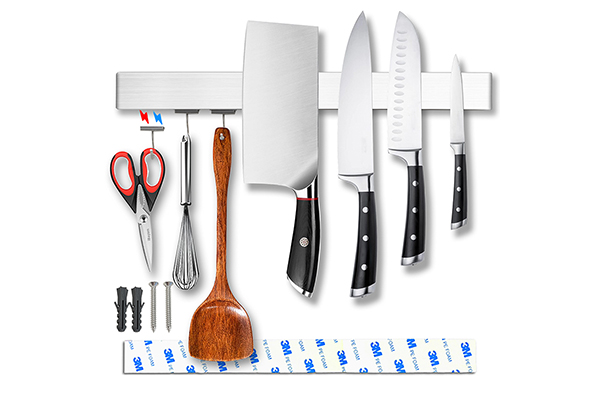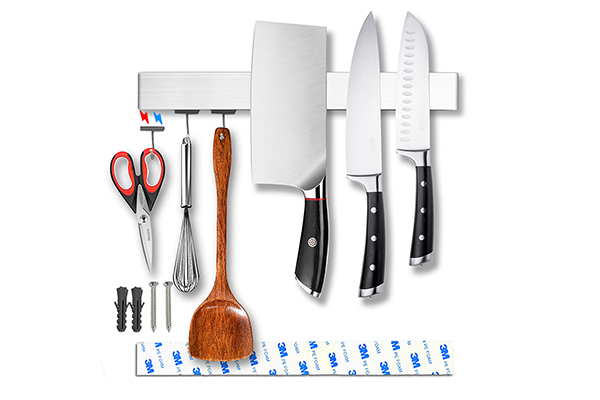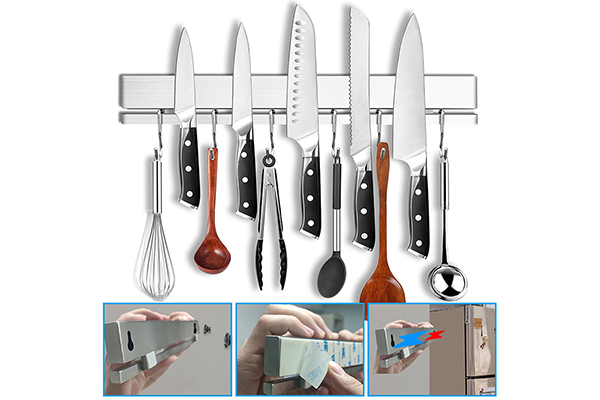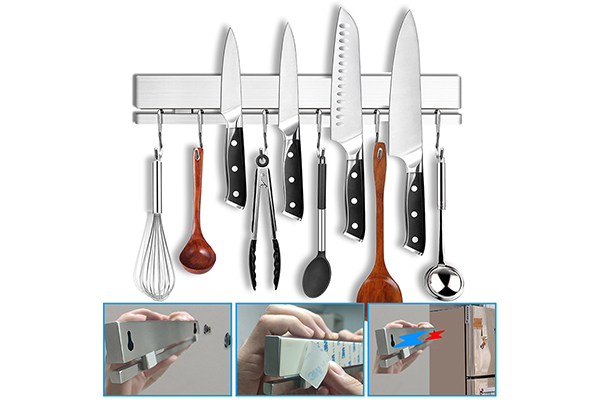Is the magnetic suction knife seat suitable for all types of knives?
Release Time : 2025-03-06
The magnetic suction knife seat is not suitable for all types of knives. The magnetic suction knife seat mainly relies on magnetic force to adsorb and fix the knives, so its scope of application is mainly limited to ferromagnetic knives. Ferromagnetic knives refer to those knives that can be attracted by magnets, such as common carbon steel knives, stainless steel knives, etc.
However, for non-ferromagnetic knives, such as ceramic knives, plastic knives, aluminum knives, etc., the magnetic suction knife seat cannot generate enough adsorption force to fix them. Since these non-ferromagnetic knives are not magnetic, they cannot be effectively adsorbed by the magnetic suction knife seat, which may cause the knives to loosen or fall off during the cutting process, causing safety accidents or affecting the processing quality.
The original intention of the design of the magnetic suction knife seat is to provide a convenient and efficient tool fixing solution, which is particularly suitable for those processing scenarios that require frequent tool replacement. Through magnetic adsorption, the tool can be quickly and accurately positioned on the knife seat, which improves processing efficiency and accuracy. At the same time, the magnetic suction knife seat also takes up little space and can be flexibly installed in the appropriate position of the machine tool, making it convenient for operators to access the tool.
Therefore, when choosing a magnetic suction knife seat, you need to consider the type of tool used. If you mainly use ferromagnetic tools, then the magnetic suction knife seat will be an ideal choice. But if the tool types are more diverse, including non-ferromagnetic tools, you need to consider other types of tool fixing methods to ensure safety and efficiency during processing.
Application and selection of magnetic suction knife seat
The magnetic suction knife seat has a wide range of applications in the field of mechanical processing, especially in occasions where tools need to be replaced frequently, such as mold processing, metal cutting, etc. Its advantage is that it can quickly and accurately locate the tool, improve processing efficiency, and reduce safety accidents caused by loose or falling tools.
When choosing a magnetic suction knife seat, in addition to considering the type of tool, you also need to pay attention to factors such as its suction force, size specifications, and installation method. The suction force determines the weight and cutting force of the tool that the tool holder can fix, and needs to be selected according to actual processing needs. The size specifications need to match the machine tool and tool to ensure that the tool holder can be stably installed on the machine tool and accommodate the required tool. The installation method affects the convenience and flexibility of the knife seat, and needs to be selected according to the actual processing environment and operating habits.
In addition, for occasions where the magnetic suction knife seat needs to be used for a long time, it is also necessary to pay attention to its durability and maintenance. Choosing a knife seat made of high-quality materials and processes can extend its service life and reduce downtime caused by wear or damage. At the same time, regular maintenance, such as cleaning the surface and checking the suction, can also ensure that the knife seat always maintains optimal performance.
In summary, the magnetic suction knife seat is not suitable for all types of knives, but mainly for ferromagnetic knives. When choosing a magnetic suction knife seat, it is necessary to comprehensively consider factors such as the type of tool used, processing requirements, size specifications, and installation methods to ensure safety and efficiency during processing.
However, for non-ferromagnetic knives, such as ceramic knives, plastic knives, aluminum knives, etc., the magnetic suction knife seat cannot generate enough adsorption force to fix them. Since these non-ferromagnetic knives are not magnetic, they cannot be effectively adsorbed by the magnetic suction knife seat, which may cause the knives to loosen or fall off during the cutting process, causing safety accidents or affecting the processing quality.
The original intention of the design of the magnetic suction knife seat is to provide a convenient and efficient tool fixing solution, which is particularly suitable for those processing scenarios that require frequent tool replacement. Through magnetic adsorption, the tool can be quickly and accurately positioned on the knife seat, which improves processing efficiency and accuracy. At the same time, the magnetic suction knife seat also takes up little space and can be flexibly installed in the appropriate position of the machine tool, making it convenient for operators to access the tool.
Therefore, when choosing a magnetic suction knife seat, you need to consider the type of tool used. If you mainly use ferromagnetic tools, then the magnetic suction knife seat will be an ideal choice. But if the tool types are more diverse, including non-ferromagnetic tools, you need to consider other types of tool fixing methods to ensure safety and efficiency during processing.
Application and selection of magnetic suction knife seat
The magnetic suction knife seat has a wide range of applications in the field of mechanical processing, especially in occasions where tools need to be replaced frequently, such as mold processing, metal cutting, etc. Its advantage is that it can quickly and accurately locate the tool, improve processing efficiency, and reduce safety accidents caused by loose or falling tools.
When choosing a magnetic suction knife seat, in addition to considering the type of tool, you also need to pay attention to factors such as its suction force, size specifications, and installation method. The suction force determines the weight and cutting force of the tool that the tool holder can fix, and needs to be selected according to actual processing needs. The size specifications need to match the machine tool and tool to ensure that the tool holder can be stably installed on the machine tool and accommodate the required tool. The installation method affects the convenience and flexibility of the knife seat, and needs to be selected according to the actual processing environment and operating habits.
In addition, for occasions where the magnetic suction knife seat needs to be used for a long time, it is also necessary to pay attention to its durability and maintenance. Choosing a knife seat made of high-quality materials and processes can extend its service life and reduce downtime caused by wear or damage. At the same time, regular maintenance, such as cleaning the surface and checking the suction, can also ensure that the knife seat always maintains optimal performance.
In summary, the magnetic suction knife seat is not suitable for all types of knives, but mainly for ferromagnetic knives. When choosing a magnetic suction knife seat, it is necessary to comprehensively consider factors such as the type of tool used, processing requirements, size specifications, and installation methods to ensure safety and efficiency during processing.








